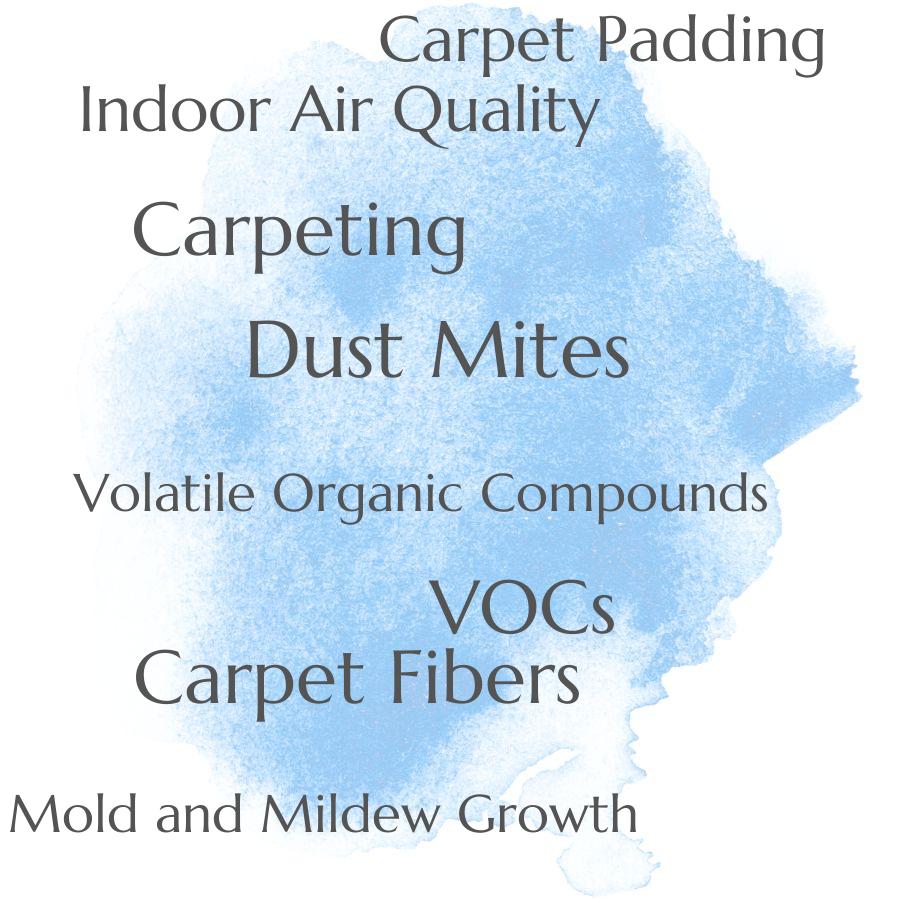Carpeting can negatively affect indoor air quality by trapping dust, pollen, and other allergens in the fibers of the carpet.
Carpeting has long been a popular flooring choice for many homes and businesses. Not only is it aesthetically pleasing, but it can also help to reduce noise and add warmth to a room.
But did you know that carpeting can also affect your indoor air quality? In this blog post, we’ll discuss how carpets can impact the air you breathe, as well as some tips on how to keep your carpets clean in order to maintain healthy indoor air quality.
Carpet Fibers

Carpet fibers can be made from natural materials such as wool, cotton, and jute, or synthetic materials such as nylon and polyester. The type of fiber used will affect how well it traps dust and other particles in the air.
Natural fibers tend to be more absorbent than synthetic ones, so they can trap more pollutants like dust mites, pet dander, pollen, mold spores and other allergens. Synthetic fibers are usually less absorbent but may still trap some pollutants if they have a tight weave or pile height.
The way carpets are installed also affects indoor air quality. If carpets are not properly installed with padding underneath them to provide cushioning and insulation against moisture buildup on the floor below them then this could lead to an increase in humidity levels which can cause mold growth on the underside of carpets leading to poor indoor air quality.
Additionally if carpets aren’t vacuumed regularly then dirt particles will accumulate over time leading to increased levels of airborne particulates which can further reduce indoor air quality.
Carpet Padding
It serves several purposes, including providing cushioning for comfort, insulation to reduce noise levels, and protection from wear and tear. It can also help improve indoor air quality by trapping dust particles and other allergens in its fibers.
This helps keep them out of the air we breathe, reducing the amount of pollutants in our homes or offices. Carpet padding also acts as a filter for airborne particles such as pollen or pet dander that may be present in our environment.
By trapping these particles within its fibers, it prevents them from entering our lungs when we inhale. As a result, carpet padding can help reduce allergies and asthma symptoms caused by poor indoor air quality.
Volatile Organic Compounds (VOCs)
VOCs can have a negative effect on indoor air quality because they are often toxic and can cause health problems when inhaled. Carpeting is one of the most common sources of VOCs in homes and businesses, as it contains many different types of chemicals that can be released into the air over time.
These chemicals include formaldehyde, benzene, toluene, xylene, styrene and other organic compounds. When these compounds are released into the air through off-gassing from carpets or other materials containing them, they can cause respiratory irritation and other health issues for those exposed to them.
To reduce exposure to VOCs from carpets, it is important to choose low-emitting products with minimal chemical content and ensure proper ventilation in areas where carpets are installed.
Dust Mites
Dust mites are microscopic creatures that feed on the dead skin cells that humans and animals shed every day. They thrive in warm, humid environments and can be found in carpets, furniture, bedding, and other soft surfaces.
Carpeting provides an ideal habitat for dust mites because of its warmth and humidity-retaining properties. As they move around the carpet fibers, they release their waste products into the air which can cause allergies or asthma symptoms in some people.
Vacuuming carpets regularly helps reduce the number of dust mites present by removing their food source (dead skin cells).
Mold and Mildew Growth
Carpeting is especially prone to mold and mildew growth due to its absorbent nature, which allows moisture from the air or spills to become trapped in the fibers. This creates an ideal environment for mold and mildew spores to thrive, leading to their rapid growth.
As these organisms grow, they release spores into the air that can cause allergic reactions in people who are sensitive or have asthma. Some types of mold produce toxins that can be hazardous if inhaled over long periods of time.
To prevent this from happening, carpets should be regularly vacuumed and cleaned with appropriate cleaning solutions designed specifically for carpets.
Allergens
Allergens are substances that cause an allergic reaction in some people, such as dust mites, pet dander, and mold spores. Carpeting can trap these allergens in its fibers and prevent them from being released into the air.
This means that if someone with allergies is living or working in a space with carpeting, they may be exposed to higher levels of allergens than if there was no carpet present. Vacuuming carpets regularly can help reduce the amount of allergens present by removing them from the fibers before they have a chance to become airborne.
Chemical Treatments Used On Carpets
One way this happens is through the use of chemical treatments applied to carpets. These treatments are used to protect carpets from dirt, stains, and wear-and-tear, but they can also release volatile organic compounds (VOCs) into the air.
VOCs are chemicals that evaporate at room temperature and can cause health problems such as headaches, nausea, and respiratory issues when inhaled in large amounts over long periods of time. The most common VOCs found in carpeting include formaldehyde, benzene, toluene, ethylene glycol monobutyl ether (EGBE), and xylene.
It is important for homeowners to be aware of these potential risks when selecting carpeting for their home or office space so that they can make an informed decision about what type of treatment is best for them.